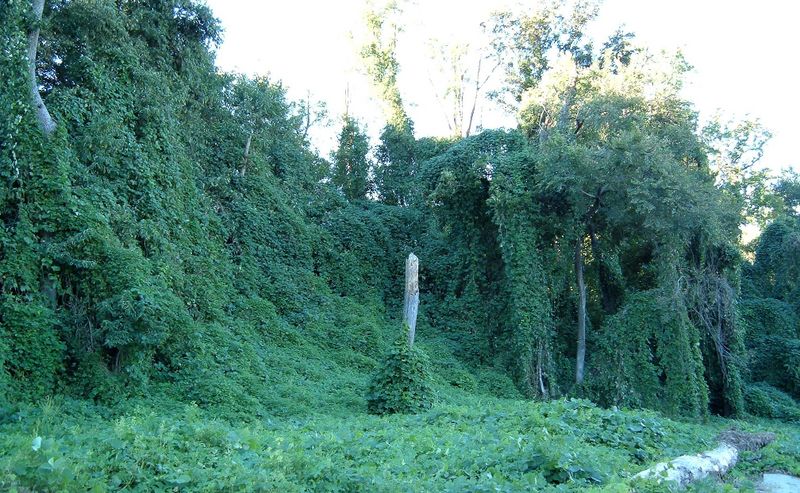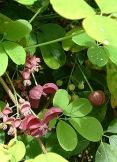Yikes! There are thugs out there. Plants that want to rob you of your garden.
This is not a debate about using native plants rather than foreign invaders. There are many fine native plants, but there are so many wonderful non-natives that it would be shameful to exclude them. I’ll try just about anything that looks good in my garden, and I’ve paid the price for some poor choices.
 To be clear, I don’t want to encourage using plants that have proven to be invasive. That is irresponsible, but invasive plant lists have become a political mess including plants that have little business being there. There are a handful of “invasive” plants that are amongst the more popular plants in the nursery business, and deservedly so.
To be clear, I don’t want to encourage using plants that have proven to be invasive. That is irresponsible, but invasive plant lists have become a political mess including plants that have little business being there. There are a handful of “invasive” plants that are amongst the more popular plants in the nursery business, and deservedly so.
I’ve had plenty of experience with plants that look good, sound good, but don’t behave in the garden. Often it takes considerable effort to banish these plants.
The worst experiences I’ve had have been with vines, though not the kudzu pictured above. When a gardener begins to run short on space he looks to expand vertically, with arbors, lattice, and trellises, and many vines are aggressive.
The lattice below my deck yearns for a plant that will cover it, but not try to take over, the perfect plant that grows to just the right size then stops. Of course, such a plant doesn’t exist, and I’ve had plenty that covered the lattice in a hurry with no intention of ever slowing down.
 The worst had to be Akebia, Chocolate vine. It has attractive foliage and interesting blooms, and it grew just fine, and grew, and grew. I chopped it back and back again, and it grew back with a vengence, threatening to cover the deck . And then it appeared on the other side of the deck twenty feet away, which I thought was kind of nice until I looked and there were hundreds of stems growing in that direction. I got the message and started a two year battle to get rid of it. I’m sure that there’s a good place for akebia, but on my deck wasn’t it.
The worst had to be Akebia, Chocolate vine. It has attractive foliage and interesting blooms, and it grew just fine, and grew, and grew. I chopped it back and back again, and it grew back with a vengence, threatening to cover the deck . And then it appeared on the other side of the deck twenty feet away, which I thought was kind of nice until I looked and there were hundreds of stems growing in that direction. I got the message and started a two year battle to get rid of it. I’m sure that there’s a good place for akebia, but on my deck wasn’t it.
 I’ve finally settled on Clematis montana rubens for the lattice. It has an aggressive habit for a clematis, but it’s very manageable, and is about as close to perfect for this spot as I think I’m going to get. I have other clematis, and wish that they were half as vigorous as montana rubens.
I’ve finally settled on Clematis montana rubens for the lattice. It has an aggressive habit for a clematis, but it’s very manageable, and is about as close to perfect for this spot as I think I’m going to get. I have other clematis, and wish that they were half as vigorous as montana rubens.
The longest battle I’ve fought to be rid of a thug was with Wisteria. It was beautiful. I built a heavy duty arbor which was covered the first year by its rapid growth. Though I paid no attention to pruning guidelines said to encourge better flowering it was a prolific bloomer. However, rather than pruning to encourage flowers I was pruning for survival. And then the trunk strangled and splintered my arbor, and I realized the time had come.
A chainsaw and Roundup proved no match for this vine. It came back from the roots, and from seed, and before you know it you have ten or fifteen more growing about the garden. The wisteria has been gone for several years, but the fight goes on. I’m winning, but don’t feel confident enough to claim victory.
Others vines have offered mixed success. For a short time I had the nicest variegated Porcelainberry until it started seeding about, and had to go. Since then it’s become one of the more notorious invasives. By some good fortune the forest bordering my property isn’t covered over by this attractive thug.
I’ve had a tussle or two with Ivy, but this is one “invasive” that I feel good about in my garden. The adult form that goes to seed is rarely seen, and never in my garden, so there’s no concern that it will escape. I have at least a handful of variegated and odd shaped leafed varieties growing here and there, and only once have I had to tame it to behave with its neighboring plants. I have no doubt that it can overwhelm a garden if given free reign, but the effort to keep it in line has been minor.
 Another vine with a bad reputation, but not so bad a bite, is Honeysuckle ‘Mardi Gras’. No doubt that some honeysuckles can be a scourge, but Mardi Gras is a delightful vine. It requires support as it does not have aerial roots, or tendrils to secure it as it climbs, but I have found that is not an overly aggressive grower, and is superb in bloom.
Another vine with a bad reputation, but not so bad a bite, is Honeysuckle ‘Mardi Gras’. No doubt that some honeysuckles can be a scourge, but Mardi Gras is a delightful vine. It requires support as it does not have aerial roots, or tendrils to secure it as it climbs, but I have found that is not an overly aggressive grower, and is superb in bloom.
Thuggish behavior is not limited to vines. I’ve had unfortunate experiences with grasses, bamboo, and trees.
I’ve seen that Miscanthus has escaped area gardens into the wild, though not widespread, but I had to fight for several years to rid my garden of black fountain grass, Pennisetem ‘Moudry’. Perhaps the most ornamental fountain grass, I believe that every seed germinated. Now, thank goodness, I am rid of this beast.
That bamboos can be notoriously invasive should not be a secret, but gardeners are endlessly intrigued by them, so what could be harmed by planting one over in the corner? Not the large yellow bamboo, but one of the cute variegated dwarf kinds. Now, intrigued no more, I’ve surrendered that corner, and a few others. I fear that this battle is too hopeless to fight.
But I’ve planted other bamboos with great success. The Fargesias are quite tame clumpers. Over five years mine has spread no more than a foot or two, and is a valued addition to the garden. I would recommend this plant to all, but I warn against any form of bamboo that is defined as a runner. Regardless of installing plastic or concrete barriers you will lose this race.
And alas, the end of my tragedies, and one I live with today, is the Golden Rain tree. A lovely tree of medium height with hanging yellow flowers, I am convinced that every seed (and there are thousands) germinates. The area beneath the golden rain becomes a carpet of seedlings, and the hard, round, black seeds roll into other parts of the garden for me to pull. I don’t believe that birds eat this seed since I have not witnessed seedlings outside my property, but there are so many other superb trees that there should be no need to live with one with such significant faults.
Through all these mistakes I am not discouraged. While each seemed a catastrophe at the time, I am undeterred in the pursuit of the next unexpected garden treasure. My advice is to turn to experienced hands to learn from their prizes, as well as their horrors.
Great post. I especially like “I would recommend this plant to all, but I warn against any form of bamboo that is defined as a runner. Regardless of installing plastic or concrete barriers you will lose this race.”
I love the pictures we learned a little about the kudzu plant in school. i live in Massachusetts but things like this are really interesting and explain why we have to be checked at borders in case were bring things like this into other parts of the world. Thanks!
-Adele J.
Adele, I’ve been in areas in the mountains of North Carolina where the roads would be covered with kudzu if cars didn’t prune it by driving over it. Unfortunately, kudzu didn’t sneak into the US as some other invasives have done. There was plenty of research that recommended it for erosion control and for cattle feed.
Today, we are more aware of the potential problems with bringing in non-natives, but the danger now is with plants brought to this country as ornamentals. Most are fine, but there is still the possibility of introducing an invasive.
Wonderfully well executed post